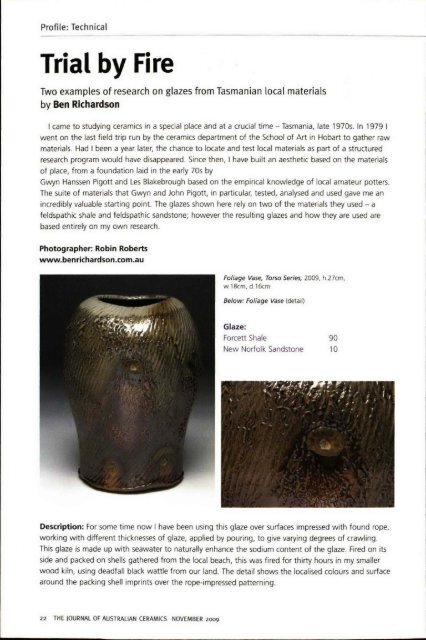The Journal of Australian Ceramics Vol 48 No 3 November 2009
Create successful ePaper yourself
Turn your PDF publications into a flip-book with our unique Google optimized e-Paper software.
Pr<strong>of</strong>ile: Technica l<br />
Trial by Fire<br />
Two examples <strong>of</strong> research on glazes from Tasmanian local materials<br />
by Ben Richardson<br />
I came to studying ceramics in a special place and at a crucial time - Tasmania, late 1970s. In 1979 I<br />
went on the last field trip run by the ceramics department <strong>of</strong> the School <strong>of</strong> Art in Hobart to gather raw<br />
materials. Had I been a year later, the chance to locate and test local materials as part <strong>of</strong> a structured<br />
research program would have disappeared . Since then, I have built an aesthetic based on the materials<br />
<strong>of</strong> place, from a foundation laid in the early 70s by<br />
Gwyn Hanssen Pigott and Les Blakebrough based on the empirical knowledge <strong>of</strong> local amateur potters.<br />
<strong>The</strong> suite <strong>of</strong> materials that Gwyn and John Pigott, in particular, tested, analysed and used gave me an<br />
incredibly valuable starting point. <strong>The</strong> glazes shown here rely on two <strong>of</strong> the materials they used - a<br />
feldspathic shale and feldspathic sandstone; however the resu lting glazes and how they are used are<br />
based entirely on my own research .<br />
Photographer: Robin Roberts<br />
www.benrichardson.com.au<br />
Foliage Vase, Torso Series, <strong>2009</strong>, h.27cm,<br />
w.18cm. d .16cm<br />
Below: Foliage Vase (detail)<br />
Glaze:<br />
Forcett Shale 90<br />
New <strong>No</strong>rfolk Sandstone 10<br />
Description: For some time now I have been using this glaze over surfaces impressed with found rope,<br />
working with different thicknesses <strong>of</strong> glaze, applied by pouring, to give varying degrees <strong>of</strong> crawling .<br />
This glaze is made up with seawater to naturally enhance the sodium content <strong>of</strong> the glaze. Fired on its<br />
side and packed on shells gathered from the loca l beach, this was fired for thirty hours in my smaller<br />
wood kiln, using deadfall black wattle from our land. <strong>The</strong> detail shows the localised colours and surface<br />
around the packing shell imprints over the rope-impressed patterning.<br />
22 THE JOURNAL OF AUSTRALIAN CERAMICS NOVEMBER <strong>2009</strong>


















